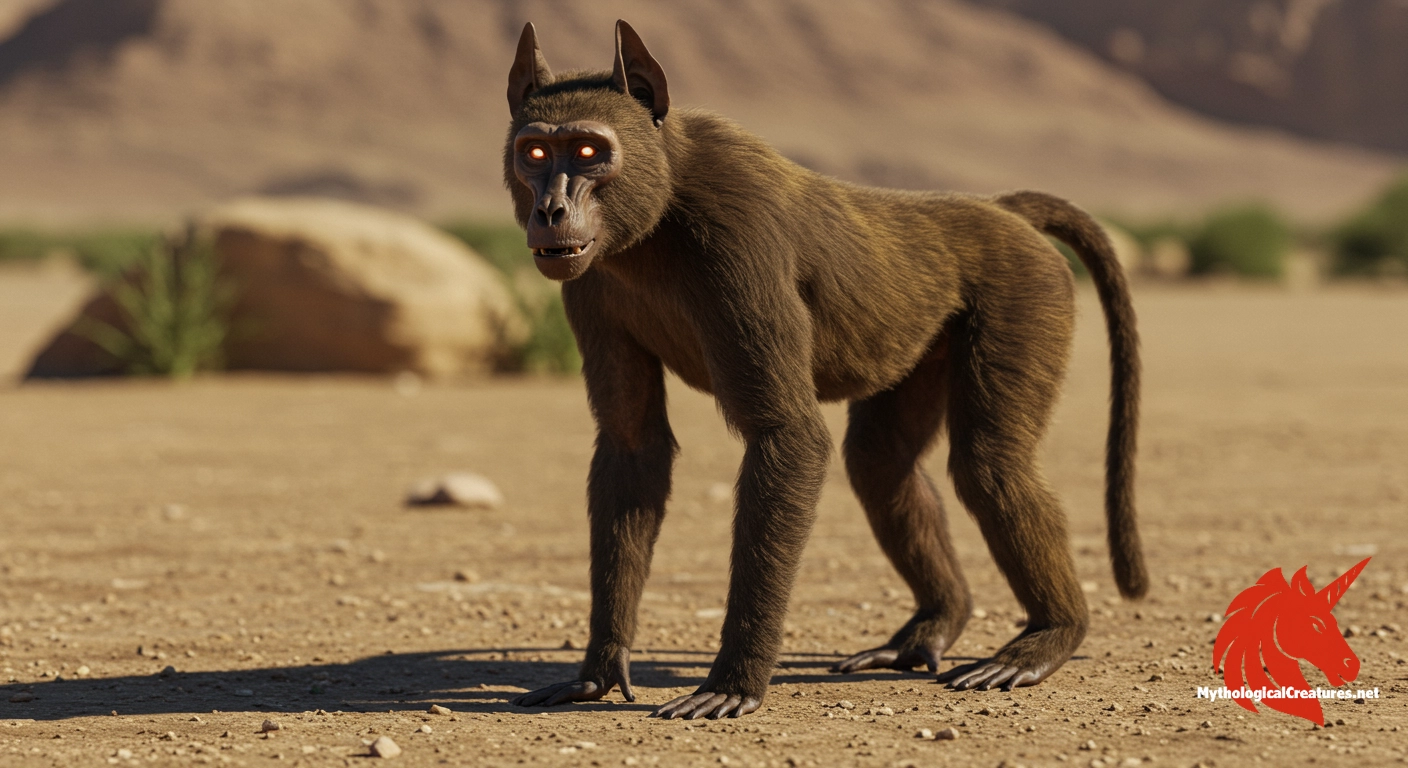Aani: Aani is the Cynocephalus Baboon, a sacred animal in ancient Egyptian religion closely associated with the god Thoth.

Aani
Aani - Aani symbolizes wisdom and intellectual power, serving as a sacred icon of Thoth in ancient Egyptian religion.
Origins & First Encounters
Aani emerges from the mythic landscape of ancient Egypt as a striking figure that combines both canine and primate attributes in a unique synthesis revered for its divine associations. Its depiction as a dog‐headed ape is deeply interwoven with the attributes of Thoth, the god of wisdom, writing, and cosmic order. This creature is rooted in a long tradition of symbolic animal forms, evolving from early hieroglyphic representations that date back to the Old Kingdom. The figure first appears in temple reliefs and sacred inscriptions, where its portrayal underscores a connection between the physical and the metaphysical. Ancient Egyptians saw in Aani a living emblem of intelligence and insight, capable of bridging mortal realms with divine mysteries. The creature’s hybrid form not only reflects nature’s diversity but also speaks to the rich allegorical language of Egyptian religious art. Artists crafted its image with a reverence that elevated naturalistic detail into layers of symbolic meaning. Religious rituals and temple ceremonies often incorporated Aani as a visual mediator of Thoth’s qualities, thus reinforcing its spiritual stature. Its enduring representation in various media highlights the interplay of religious devotion and mythic narrative in the cultural consciousness of ancient Egypt. The story of Aani encapsulates a broader cultural appreciation for creatures that embody both the wild and the wise.
Source Texts & Tale Variants
Ancient texts and monumental inscriptions offer a window into the rich tapestry of narratives surrounding Aani. The creature is attested in roughly forty distinct passages across religious and funerary literature, each contributing a facet to its complex identity. One notable account from an 18th Dynasty text expressly links the baboon aspect of Aani to the divine persona of Thoth. Hieroglyphic texts from various temple complexes portray the creature with precise detail, ensuring its role within the religious iconography was unmistakable. Variants in the recorded depictions reveal that the creature was not only symbolic of Thoth but also shared its visual domain with other deities such as Hapy and Khonsu. Papyrus fragments, temple reliefs, and tomb inscriptions collectively offer multiple perspectives on the creature’s role in sacred rites and mythological storytelling. Despite occasional discrepancies across different sources, a common thread of wisdom and divine association is evident in all references. The diverse literary accounts affirm that Aani was both a symbolic icon and a narrative device, enriching the mythological corpus. These textual sources continue to provide modern scholars with invaluable insights into how ancient Egyptians bridged the nature of animals with aspects of the divine. Rich narrative variants from these ancient documents iteratively reaffirm the creature’s sacred status and its multifaceted role in spiritual traditions.
Form & Powers
Visually, Aani is rendered with a distinctive amalgamation of features that echo both canine alertness and the primate’s agile nature. Artists often depict it with a pronounced muzzle and a textured mane of fur, merging the familiar traits of a dog with those of the baboon. Its face is composed of sharp, intelligent eyes that seem to convey a deep, otherworldly knowledge. Detailed renderings frequently highlight its elongated snout paired with a subtle facial structure, marking it as neither entirely animalistic nor wholly divine. The creature’s body is sculpted to suggest both strength and grace, with sinewy limbs that evoke a sense of perpetual motion and vigilance. Regalia and hieroglyphic symbols often adorn its form, linking it to Thoth’s divine portfolio and the broader cosmological order. Variations in artistic style over time have led to slight differences in the creature’s proportions, yet a core visual canon remains consistent. Intricate carvings on temple walls capture its essence, ensuring that each depiction reflects a balance between raw nature and meticulously symbolic artistry. In every portrayal, Aani’s physical form serves as a powerful visual language that celebrates the intersection of the human and the divine. The careful attention to detail in its imagery underscores a deep cultural fascination with the transformative qualities of nature.
Regional Faces
Regional manifestations of Aani in ancient Egypt display intriguing stylistic differences that speak to local artistic sensibilities and cultic practices. In the northern regions along the Delta, depictions often exhibit a more refined and almost aristocratic visage, reflecting a sophisticated urban aesthetic. By contrast, portrayals from Upper Egypt tend to emphasise a raw, vigorous form that mirrors the rugged terrain and local traditions. Temples in centres like Hermopolis, where Thoth’s cult was particularly prominent, showcase Aani in a manner that intertwines scholarly symbolism with naturalistic detail. These regional variations are not merely artistic; they also hint at differing ritualistic emphases and local mythic interpretations. In some locales, the creature's features were accentuated with additional decorative motifs, aligning it more closely with the dominant cultural iconography of the area. External influences during the Greco-Roman period further enriched these regional depictions, introducing hybrid artistic elements and new layers of meaning. This creative confluence fostered a dynamic visual evolution, allowing Aani to embody a spectrum of symbolic attributes across the Egyptian landscape. Through these diverse adaptations, the icon of Aani transcended local boundaries to contribute to a unified yet varied religious narrative. The persistence of region-specific details underscores a vibrant cultural dialogue between local tradition and pan-Egyptian religious identity.
Cultural Parallels
Exploring Aani in a cross-cultural context reveals compelling thematic parallels and unique contrasts with other mythological beings. The creature’s dog-headed features resonate with the mythical Cynocephali encountered in various Greco-Roman accounts, where dog-headed figures often symbolised the limits of the known world. In several traditions, anthropomorphic animals serve as conduits for divine wisdom, much like Aani does in Egyptian lore. Similar to how the monkey-god figures in Hindu narratives blend mischief with sagacity, Aani epitomises the dualities of cleverness and reverence. Such similarities highlight a shared human endeavour to represent the mysteries of nature through composite forms. At the same time, Aani’s explicit association with Thoth distinguishes it from other mythic hybrids by anchoring it in the symbolic realms of knowledge and cosmic order. This creature’s appearance also invites comparisons with other divine animal representations, where form and function merge to create potent symbols of cultural values. The recurring motif of combining human and animal traits across cultures underscores a universal fascination with the boundary between the natural and the supernatural. Intersections between Aani and its comparative counterparts shed light on broader, cross-cultural narratives about wisdom, transformation, and spirituality. Ultimately, the study of Aani within this comparative framework deepens our appreciation for the ways in which myth continuously evolves to meet the symbolic needs of diverse societies.
Legacy & Modern Evolution
The legacy of Aani reflects a captivating journey from ancient ritual to modern reinterpretation, all the while retaining an aura of mystique and intellectual gravitas. In antiquity, the creature was revered not only as a sacred icon of Thoth but also as an embodiment of wisdom and creative inspiration. Over time, its distinct visual attributes influenced a range of artistic traditions, ensuring that its image would remain a powerful reference point in both religious iconography and mythological symbolism. Contemporary art and literature continue to draw upon the mystique of Aani, often reimagining its hybrid form as a symbol of the enduring quest for knowledge. Modern architects and designers have incorporated elements reminiscent of Aani’s imagery in their works, linking the ancient past with present-day creative expression. This evolution has also seen the creature transition from a strictly religious symbol to a broader emblem of intellectual curiosity and innovative thinking. Re-examinations of its myth have found fertile ground in academic circles, where scholars explore its thematic resonance across cultures and eras. Popular media and digital art further celebrate the enigmatic quality of Aani, ensuring its presence in the modern cultural narrative. The continuous rearticulation of Aani’s image serves as a reminder of the timeless human fascination with hybrid forms and the mysteries they embody. Its evolving legacy invites both scholarly debate and artistic exploration, affirming that ancient mythologies still hold a profound relevance in contemporary society.
Interesting Fact
The depiction of Aani as a dog-headed ape uniquely blends animal traits to convey divine wisdom, exemplifying the rich symbolic artistry of ancient Egyptian religion.
Quick Creature Info
Origin:
Features:
Associations:
Our Mythic Legendary Rating:

Also Sometimes Known As:
Habitat:
Supernatural Powers:
Physical Attributes:
Abilities:
Lore:
References
Discover Another Mythical Legend You May Not Have Heard Of?
Uncover the mysteries of ancient folklore and expand your knowledge of legendary beings from cultures around the world.
Dare to Meet the Njörðr....
Mythical Disclaimer: The images and data on this site are derived from various historical and literary sources, but we have found that many myths often have multiple versions and interpretations across references, sometimes contradictory. As a result, these creature depictions are artistic interpretations—imaginative blends of folklore, legend, and a dash of AI guesswork. Because creature descriptions vary widely, our illustrations and accompanying information represent our best effort to honor mythology while bridging creative gaps. Enjoy these interpretations—just remember, we've done our best to respect the stories and validate available data, but in the realm of mythology, details often shift, imagination leads the way, and nothing is ever set in stone!
Curated by the Mythological Creatures Team (rev. May 2025)
